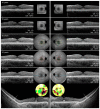Stargardt-like Clinical Characteristics and Disease Course Associated with Variants in the WDR19 Gene
- PMID: 36833218
- PMCID: PMC9957452
- DOI: 10.3390/genes14020291
Stargardt-like Clinical Characteristics and Disease Course Associated with Variants in the WDR19 Gene
Abstract
Variants in WDR19 (IFT144) have been implicated as another possible cause of Stargardt disease. The purpose of this study was to compare longitudinal multimodal imaging of a WDR19-Stargardt patient, harboring p.(Ser485Ile) and a novel c.(3183+1_3184-1)_(3261+1_3262-1)del variant, with 43 ABCA4-Stargardt patients. Age at onset, visual acuity, Ishihara color vision, color fundus, fundus autofluorescence (FAF), spectral-domain optical coherence tomography (OCT) images, microperimetry and electroretinography (ERG) were evaluated. First symptom of WDR19 patient was nyctalopia at the age of 5 years. After the age of 18 years, OCT showed hyper-reflectivity at the level of the external limiting membrane/outer nuclear layer. There was abnormal cone and rod photoreceptor function on ERG. Widespread fundus flecks appeared, followed by perifoveal photoreceptor atrophy. Fovea and peripapillary retina remained preserved until the latest exam at 25 years of age. ABCA4 patients had median age of onset at 16 (range 5-60) years and mostly displayed typical Stargardt triad. A total of 19% had foveal sparing. In comparison to ABCA4 patients, the WDR19 patient had a relatively large foveal preservation and severe rod photoreceptor impairment; however, it was still within the ABCA4 disease spectrum. Addition of WDR19 in the group of genes producing phenocopies of Stargardt disease underlines the importance of genetic testing and may help to understand its pathogenesis.
Keywords: ABCA4; IFT144; Stargardt disease; Stargardt-like disease; WDR19; fundus flavimaculaus; phenocopy.
Conflict of interest statement
The authors declare no conflict of interest.
Figures













Similar articles
-
Early-onset stargardt disease: phenotypic and genotypic characteristics.Ophthalmology. 2015 Feb;122(2):335-44. doi: 10.1016/j.ophtha.2014.08.032. Epub 2014 Oct 17. Ophthalmology. 2015. PMID: 25444351
-
Early Patterns of Macular Degeneration in ABCA4-Associated Retinopathy.Ophthalmology. 2018 May;125(5):735-746. doi: 10.1016/j.ophtha.2017.11.020. Epub 2018 Jan 6. Ophthalmology. 2018. PMID: 29310964 Free PMC article.
-
Full-field ERG as a predictor of the natural course of ABCA4-associated retinal degenerations.Mol Vis. 2018 Jan 4;24:1-16. eCollection 2018. Mol Vis. 2018. PMID: 29386879 Free PMC article.
-
Stargardt Disease.Adv Exp Med Biol. 2018;1085:139-151. doi: 10.1007/978-3-319-95046-4_27. Adv Exp Med Biol. 2018. PMID: 30578500 Review.
-
Insights into the Molecular Properties of ABCA4 and Its Role in the Visual Cycle and Stargardt Disease.Prog Mol Biol Transl Sci. 2015;134:415-31. doi: 10.1016/bs.pmbts.2015.06.008. Epub 2015 Jul 14. Prog Mol Biol Transl Sci. 2015. PMID: 26310168 Review.
Cited by
-
Phenotypic spectrum and theoretical prime editing analysis of WDR19-mediated retinal degeneration.Doc Ophthalmol. 2025 Jun;150(3):155-167. doi: 10.1007/s10633-025-10016-3. Epub 2025 Apr 4. Doc Ophthalmol. 2025. PMID: 40183892 Free PMC article.
-
Dynamic Outlier Slicing Allows Broader Exploration of Adaptive Divergence: A Comparison of Individual Genome and Pool-Seq Data Linked to Humic Adaptation in Perch.Mol Ecol. 2025 Jan 23;34(4):e17659. doi: 10.1111/mec.17659. Online ahead of print. Mol Ecol. 2025. PMID: 39846218 Free PMC article.
References
Publication types
MeSH terms
Substances
LinkOut - more resources
Full Text Sources
Medical
Molecular Biology Databases

